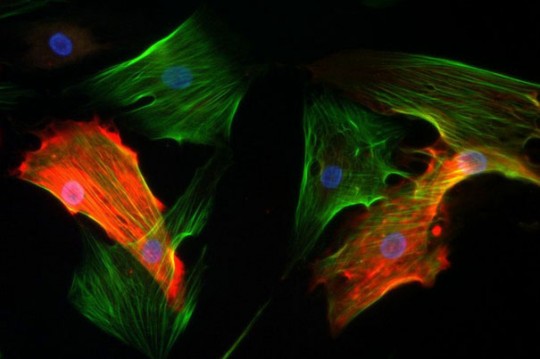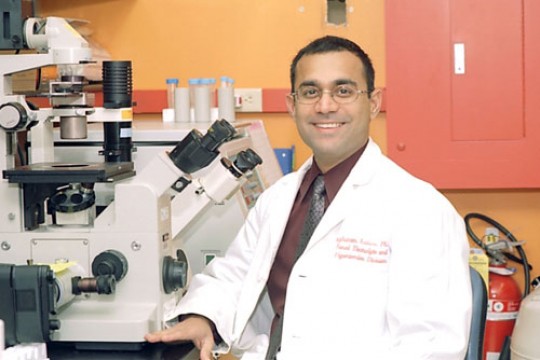Tumor cells can prevent tumor spread.
Tumor cells can prevent tumor spread.
Paradoxical discovery finds cells known as pericytes help prevent metastasis.
 Cultured pericytes (red) and myofibroblasts (green) are two prominent noncancer cells within a tumor./Credit: Vesselina Cooke/BIDMC
Cultured pericytes (red) and myofibroblasts (green) are two prominent noncancer cells within a tumor./Credit: Vesselina Cooke/BIDMC
A new study finds that a group of little-explored cells in the tumor microenvironment likely serves as an important gatekeeper against cancer progression and metastasis. Published in the Jan. 17 issue of Cancer Cell, the study’s findings suggest that antiangiogenic therapies — which shrink cancer by cutting off tumors’ blood supply — may be inadvertently making tumors more aggressive and likely to spread.
One approach to treating cancer targets angiogenesis, or blood vessel growth. In this new investigation, senior author Raghu Kalluri, chief of the Division of Matrix Biology at Beth Israel Deaconess Medical Center (BIDMC) and professor of medicine at Harvard Medical School (HMS), wanted to find out if targeting a specific cell type, the pericyte, could inhibit tumor growth in the same way that other antiangiogenic drugs do. Pericytes are an important part of tissue vasculature, covering blood vessels and supporting their growth.
 “If you just looked at tumor growth, the results were good,” says senior author Raghu Kalluri, chief of the Division of Matrix Biology at Beth Israel Deaconess Medical Center. “But when you looked at the whole picture, inhibiting tumor vessels was not controlling cancer progression. The cancer was, in fact, spreading.”/ Courtesy of BIDMC
“If you just looked at tumor growth, the results were good,” says senior author Raghu Kalluri, chief of the Division of Matrix Biology at Beth Israel Deaconess Medical Center. “But when you looked at the whole picture, inhibiting tumor vessels was not controlling cancer progression. The cancer was, in fact, spreading.”/ Courtesy of BIDMC
Kalluri and his colleagues began by creating mice genetically engineered to support drug-induced depletion of pericytes in growing tumors. They then deleted pericytes in implanted mouse breast cancer tumors, decreasing pericyte numbers by 60 percent. The researchers saw a 30 percent decrease in tumor volumes in the deleted pericyte tumors compared with wild-type controls over 25 days. However, contrary to conventional clinical wisdom, the investigators found that the number of secondary lung tumors in the engineered mice had increased threefold compared with the control mice, indicating that the tumors had metastasized.
“If you just looked at tumor growth, the results were good,” says Kalluri. “But when you looked at the whole picture, inhibiting tumor vessels was not controlling cancer progression. The cancer was, in fact, spreading.”
To understand the mechanism behind this increased metastasis, Kalluri and his team examined the tumor’s microenvironment to find out what changes were taking place at the molecular level. They found a fivefold percentage increase in hypoxic areas in tumors lacking pericytes. “This suggested to us that without supportive pericytes, the vasculature inside the tumor was becoming weak and leaky — even more so than it already is inside most tumors — and this was reducing the flow of oxygen to the tumor,” explains Kalluri.
“Cancer cells respond to hypoxia by launching genetic survival programs,” he adds. To that end, the investigators found evidence of epithelial-to-mesenchymal transition (EMT), a change that makes the cells more mobile, so they can travel through those leaky vessels to new locations, and makes them behave more like stem cells, so they are better able to survive. Experiments that demonstrated fivefold increases in protein markers of EMT showed that the cells had undergone the change. The team also found a fivefold increase in activation of Met, a receptor molecule that promotes cell migration and growth.
Importantly, the team found that these molecular changes occurred inside the smaller, pericyte-depleted tumors that had increased incidences of secondary tumors in the lungs in the mouse models. “This suggested that smaller tumors are shedding more cancer cells into the blood and causing more metastasis,” says Kalluri. “We showed that a big tumor with good pericyte coverage is less metastatic than a smaller tumor of the same type with less pericyte coverage.”
Because cancer therapies such as Imatinib, Sunitinib, and others have been shown to decrease pericytes in tumors, the researchers’ next step was to perform the same experiments in mice with primary tumors, only this time, using Imatinib and Sunitinib rather than genetic programs to decrease pericyte numbers. And while both Imatinib and Sunitinib caused a 70 percent pericyte depletion, the end results stayed the same: metastasis increased threefold. “We showed that a big tumor with good pericyte coverage is less metastatic than a smaller tumor of the same type with less pericyte coverage,” says Kalluri, who corroborated these findings in multiple types of cancer by repeating these same experiments with implanted renal cell carcinoma and melanoma tumors.
Additional experiments showed that combining pericyte-depleting drugs with the Met-inhibiting drug helped suppress EMT and metastasis.
Finally, to determine whether the findings were relevant to patients, the scientists examined 130 breast cancer tumor samples of varying cancer stages and tumor sizes and compared pericyte levels with prognosis. They found that samples with low numbers of pericytes in tumor vasculature and high levels of Met expression correlated with the most deeply invasive cancers, distant metastasis, and five- and 10- year survival rates lower than 20 percent.
“These results are quite provocative and will influence clinical programs designed to target tumor angiogenesis,” says Ronald A. DePinho, president of the University of Texas MD Anderson Cancer Center. “These impressive studies will inform and refine potential therapeutic approaches for many cancers.”
Meanwhile, for Kalluri, the work suggests that certain assumptions about cancer must be revisited. “We must go back and audit the tumor and find out which cells play a protective role versus which cells promote growth and aggression,” says Kalluri. “Not everything is black and white. There are some cells inside a tumor that are actually good in certain contexts.”
Beth Israel Deaconess Medical Center Communications
###
About Harvard Medical School (HMS)
Driving Change. Building Momentum. Making History.
“Since 1872, Harvard Medical School has been the incubator of bold ideas—a place where extraordinary people advance education, science and health care with unrelenting passion.
Whether training tomorrow’s doctors and scientists, decoding the fundamental nature of life, advancing patient care or improving health delivery systems around the world, we are never at rest. Allied with some of the world’s best hospitals, research institutes and a University synonymous with excellence, the School’s mission remains as ambitious as it is honorable: to alleviate human suffering caused by disease.”
More at Harvard Medical School & Harvard Medical School. Generations of Leaders.
_________________________________________________
###
About Harvard School of Public Health (HSPH)
Harvard School of Public Health is dedicated to advancing the public’s health through learning, discovery and communication. More than 400 faculty members are engaged in teaching and training the 1,000-plus student body in a broad spectrum of disciplines crucial to the health and well being of individuals and populations around the world. Programs and projects range from the molecular biology of AIDS vaccines to the epidemiology of cancer; from risk analysis to violence prevention; from maternal and children’s health to quality of care measurement; from health care management to international health and human rights.
More at Harvard School of Public Health (HSPH) & Harvard School of Public Health (HSPH). History.
_________________________________________________
###
About Harvard University.
Established in 1636, Harvard is the oldest institution of higher education in the United States. The University, which is based in Cambridge and Boston, Massachusetts, has an enrollment of over 20,000 degree candidates, including undergraduate, graduate, and professional students. Harvard has more than 360,000 alumni around the world.
Harvard University is devoted to excellence in teaching, learning, and research, and to developing leaders in many disciplines who make a difference globally. Harvard faculty are engaged with teaching and research to push the boundaries of human knowledge. For students who are excited to investigate the biggest issues of the 21st century, Harvard offers an unparalleled student experience and a generous financial aid program, with over $160 million awarded to more than 60% of our undergraduate students. The University has twelve degree-granting Schools in addition to the Radcliffe Institute for Advanced Study, offering a truly global education.
‘Universities nurture the hopes of the world: in solving challenges that cross borders; in unlocking and harnessing new knowledge; in building cultural and political understanding; and in modeling environments that promote dialogue and debate… The ideal and breadth of liberal education that embraces the humanities and arts as well as the social and natural sciences is at the core of Harvard’s philosophy. ’/ Drew Gilpin Faust
More About Harvard University & About Harvard University. Information.
###
* The above story is adapted from materials provided by Harvard University
_________________________________________________________________























